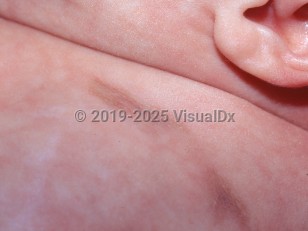Anetoderma of prematurity
Alerts and Notices
Important News & Links
Synopsis

Anetoderma is a benign condition with focal loss of collagen or elastic tissue resulting in an area of flaccid skin. Multiple types are described and are classified as primary (unknown cause) or secondary (due to a preceding disorder). Anetoderma of prematurity is a secondary anetoderma occurring in extremely premature (24-29 weeks) infants and considered related to the use of cutaneous monitoring leads or adhesives, as the skin is immature and more susceptible to damage.
Lesions are noted after infants have been in neonatal intensive care units undergoing monitoring. Skin lesions may resolve with time, but the natural history is unknown.
Lesions are noted after infants have been in neonatal intensive care units undergoing monitoring. Skin lesions may resolve with time, but the natural history is unknown.
Codes
ICD10CM:
L90.6 – Striae atrophicae
SNOMEDCT:
238828009 – Anetoderma
L90.6 – Striae atrophicae
SNOMEDCT:
238828009 – Anetoderma
Look For
Subscription Required
Diagnostic Pearls
Subscription Required
Differential Diagnosis & Pitfalls

To perform a comparison, select diagnoses from the classic differential
Subscription Required
Best Tests
Subscription Required
Management Pearls
Subscription Required
Therapy
Subscription Required
References
Subscription Required
Last Updated:10/09/2022
Anetoderma of prematurity

